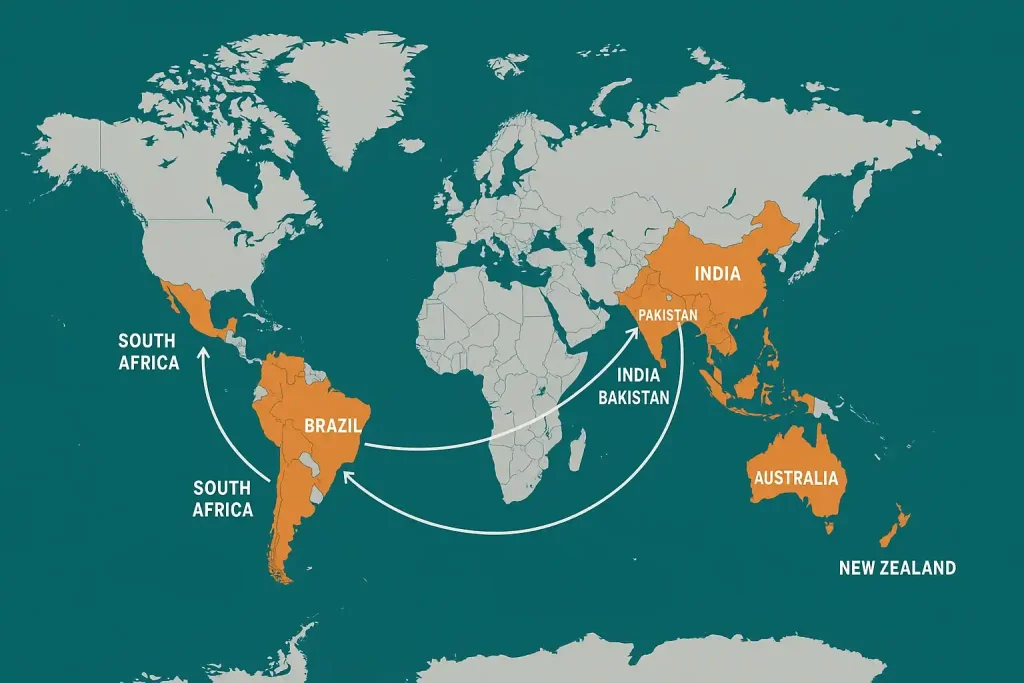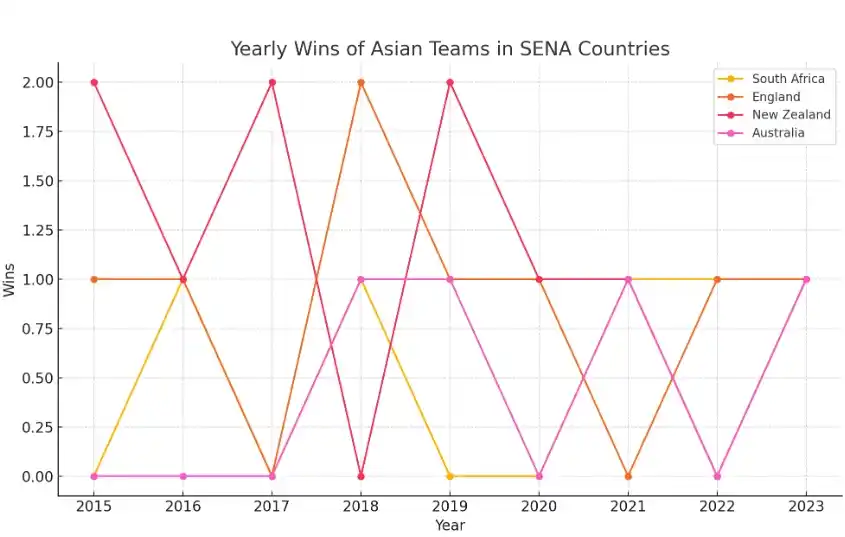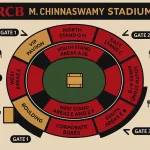
Its name surfaces quietly in commentary boxes, then bursts out in newspapers and podcasts. Former players, still haunted by chilly mornings and green tops, whisper, shout, or sigh: “Can they do it in SENA?” It is more than idle talk; it has become a marker. But what, exactly, is SENA and why does that four-letter tag bite so deeply for cricket nations?
SENA adds up to South Africa, England, New Zealand, and Australia-sturdy partners in a relentless crucible. For teams from the subcontinent—India, Pakistan, Sri Lanka, and even Bangladesh —it carries a familiar weight: noisy crowds, seamers that nibble, bouncy strips, and a cold air that slips beneath the layers. A tidy fifty in Colombo draws polite nods; a gritty fifty in Perth under Mitchell Starc earns a kind of respect money cannot buy.
That respect matters because this stretch of tours turns cricket into something sterner than a game: it becomes an exam. It tests not only technique but also temperament and nerve. Asian sides that reign at home often splinter abroad. Why do they falter? That, the deeper story, is what we are about to unpack.
The Great Divide: Why Subcontinental Flair Fizzles in SENA
The subcontinent teaches you to dance with spin, not duck under chin-music. Wickets at home grip. They spin. They reward patience, and punish speed. In SENA, though? The rules flip. Suddenly, good length is danger zone. The ball talks. It swings late. And that flair — those wristy drives, the lazy elegance — often gets found out.
But it’s more than just pitches. It’s the mental game. The weather. The media pressure. Even food. Imagine landing in Christchurch, jet-lagged, facing Boult with clouds overhead. It’s not just about playing well. It’s about surviving.
Historically, Asian teams have stumbled here. The talent was never in doubt. But resilience? That took time. And while there have been flashes of brilliance, the numbers tell a story that’s hard to ignore.
Numbers Don’t Lie: SENA Isn’t Just a Geography, It’s a Graveyard
Let’s talk data. Cold, brutal numbers. Because the performances of Asian teams in SENA aren’t about feelings. They’re about facts. And those facts paint a picture of struggle.
Table 1: Test Match Records of Asian Teams in SENA Countries (As of 2023)
| Team | Matches Played | Wins | Losses | Draws | Win % |
| India | 83 | 20 | 53 | 10 | 24.1% |
| Pakistan | 76 | 13 | 53 | 10 | 17.1% |
| Sri Lanka | 61 | 9 | 44 | 8 | 14.8% |
| Bangladesh | 22 | 1 | 20 | 1 | 4.5% |
Those win percentages? They sting. Especially for teams that dominate at home. India, the powerhouses of modern cricket, haven’t even cracked 25% win rate in these four countries.
The deeper you look, the more revealing it gets. For instance, subcontinental batting collapses are frequent in SENA. Scores like 36 all out (Adelaide, 2020) aren’t just rare blips. They’re symptoms of a larger issue: a style of play that doesn’t always travel.
The SENA Challenge: From Seam Movement to Sledging
So what exactly is the beast that is SENA? It’s not just conditions. It’s culture.
In Australia, pace is religion. Bowlers don’t just aim to dismiss. They intimidate. Think Lillee. Think Johnson. Think Cummins. The crowds join in, vocal and unforgiving. England, on the other hand, is subtle brutality. The Dukes ball seams all day. Overcast skies add spice. Slip cordons chatter. It’s chess with a bit of blood.
South Africa gives you pace and bounce, but also high-altitude drama. New Zealand? The quiet assassin. Understated venues. Nipping deliveries. Consistent, clinical execution. And every venue is a trap.
For Asian teams, raised on low bounce and turning tracks, SENA feels like a different sport. Batting techniques developed for spin-heavy tracks often unravel against relentless seam. Bowlers who feast at home with turn or reverse swing suddenly look toothless. And mentally? It wears you down. One bad session can end a Test.

Survival Stories: Moments Asian Teams Turned the Tide
Yet, amid the wreckage, there are sparks.
Picture Rahal Dravid in Adelaide, 2003. He shaped 233 and then 72 not out, turning steady defence into heavy runs. Or Virat Kohli in Centurion, 2018, facing pressure with blazing aggression. In Bangalore, 1987, Pakistan edged India and stole the series after almost losing. Two decades later, Sri Lanka swept South Africa in that rare 5-0, the first Asian side to win every match on tour.
These episodes were not only wins. They became public statements. Skill-matched mental steel proved it could flourish in ruthless arenas.
Yet, can consistency be lent to repeat those feats? That promise remains elusive. For every high, a new collapse appears. Asia still hunts a steadier recipe. Not yet.
From India to Pakistan: Who Struggles the Most and Why?
It’s tempting to lump all Asian teams together. But their journeys differ.
India has invested heavily in fitness, pace bowling, and overseas planning. The results show — they’ve won series in Australia, drawn in England. But even they falter. That 36 all out? Still fresh.
Pakistan, often brilliant but unpredictable, hasn’t translated talent into results. Politics, instability, lack of home cricket — it all adds up. Sri Lanka, once world-beaters, now struggle with transition. And Bangladesh? Still learning to walk in cricket’s toughest terrains.
Table 2: Asian Team Batting Averages in SENA Countries (Since 2000)
| Team | Average in AUS | Average in ENG | Average in SA | Average in NZ |
| India | 32.1 | 30.4 | 27.6 | 28.8 |
| Pakistan | 27.5 | 25.1 | 24.7 | 22.3 |
| Sri Lanka | 26.8 | 23.4 | 21.2 | 20.9 |
| Bangladesh | 18.4 | 17.9 | 16.2 | 15.7 |
Those averages underline the mountain. It’s not just wins. It’s about lasting long enough to fight.
Can the Gap Be Closed? Or Is This Just How It Is?
There are signs of change. Training has evolved. India now travels with pace depth. Analysts break down every movement. Players arrive weeks early to acclimatize. There’s a mental shift too — young players don’t fear SENA like the older guard did.
But systemic gaps remain. Domestic structures in Asia often don’t mimic SENA conditions. Pitches still favor turn. Seam bowlers don’t get long ropes. Until that changes, adaptation will lag behind aspiration.
Conclusion: Beyond Stats — The Spirit of Playing in SENA
What is SENA countries in the end? A graveyard for form? A litmus test for greatness? Perhaps both.
For Asian cricketers, performing in South Africa, England, New Zealand, and Australia isn’t just about runs or wickets. It’s about legacy. You can average 50 at home and still be doubted. But do it in Johannesburg or Leeds? You silence generations.
That’s why SENA matters. It’s not just another away tour. It’s where you grow up. Or get found out. It’s not fair. It never was. But then again, cricket never promised fairness. Only a chance.

Meet Arjun Kushaan, a passionate cricket analyst at The Cricket24x7. From street matches in his childhood to competitive college tournaments, cricket has always been a central part of Arjun’s life. With a strong background in data analysis and a natural affinity for numbers, he brings a fresh, analytical lens to the game. At The Cricket24x7, Arjun blends his deep love for cricket with his data-driven approach to deliver detailed insights and well-rounded coverage for fans of the sport.


